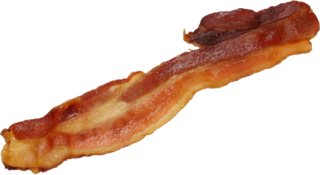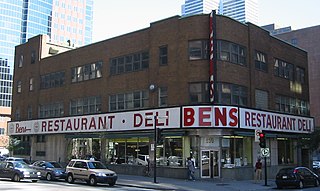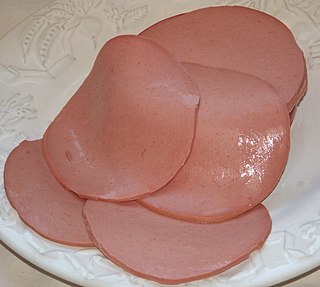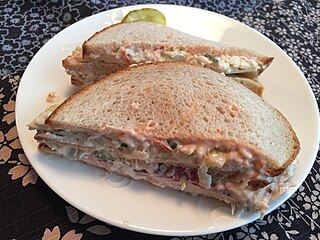
Bacon is a type of salt-cured pork made from various cuts, typically the belly or less fatty parts of the back. It is eaten as a side dish, used as a central ingredient, or as a flavouring or accent.

A sandwich is a food typically consisting of vegetables, sliced cheese or meat, placed on or between slices of bread, or more generally any dish wherein bread serves as a container or wrapper for another food type. The sandwich began as a portable, convenient finger food in the Western world, though over time it has become prevalent worldwide.

Head cheese or brawn is a cold cut terrine or meat jelly that originated in Europe. In southern Louisiana, hog's head cheese is a specialty that used to be a deli and butcher shop staple. It is made with flesh from the head of a calf or pig, typically set in aspic, and usually eaten cold, at room temperature, or in a sandwich. Despite its name the dish is not a cheese and contains no dairy products. The parts of the head used vary, and may include the tongue and sometimes the feet and heart but do not commonly include the brain, eyes or ears. Trimmings from more commonly eaten cuts of pork and veal are often used, with gelatin added as a binder.

Chorizo is a type of pork sausage originating from the Iberian Peninsula.

Traditionally, a delicatessen or "deli" is a retail establishment that sells a selection of fine, exotic, or foreign prepared foods. Delicatessen originated in Germany during the 18th century and spread to the United States in the mid-19th century. European immigrants to the United States, especially Ashkenazi Jews, popularized the delicatessen in U.S. culture beginning in the late 19th century. More recently, many larger retail stores like supermarkets have "deli" sections.

A mandoline or mandolin, is a culinary utensil used for slicing and for cutting juliennes; with suitable attachments, it can make crinkle-cuts.

A butcher is a person who may slaughter animals, dress their flesh, sell their meat, or participate within any combination of these three tasks. They may prepare standard cuts of meat and poultry for sale in retail or wholesale food establishments. A butcher may be employed by supermarkets, grocery stores, butcher shops and fish markets, slaughter houses, or may be self-employed.

A Dagwood sandwich is a tall, multilayered sandwich made with a variety of meats, cheeses, and condiments. It is named after Dagwood Bumstead, a central character in the comic strip Blondie, who is frequently illustrated making enormous sandwiches. According to Blondie scripter Dean Young, his father, Chic Young, began drawing the huge sandwiches in the comic strip during 1936.

Lunch meats—also known as cold cuts, luncheon meats, cooked meats, sliced meats, cold meats, and deli meats—are precooked or cured meats that are sliced and served cold or hot. They are typically served in sandwiches or on a tray. They can be purchased pre-sliced, usually in vacuum packs, or they can be sliced to order.

Pastrami is a food originating from Romania usually made from beef brisket, and sometimes from lamb, or turkey. The raw meat is brined, partially dried, seasoned with herbs and spices, then smoked and steamed. Like corned beef, pastrami was originally created as a way to preserve meat before the invention of refrigeration. One of the iconic meats of Romanian cuisine as well as American Jewish cuisine and the New York City cuisine, hot pastrami is typically served at delicatessen restaurants on sandwiches such as the pastrami on rye.

Horse meat forms a significant part of the culinary traditions of many countries, particularly in Eurasia. The eight countries that consume the most horse meat consume about 4.3 million horses a year. For the majority of humanity's early existence, wild horses were hunted as a source of protein.

A cleaver is a large knife that varies in its shape but usually resembles a rectangular-bladed hatchet. It is largely used as a kitchen or butcher knife and is mostly intended for splitting up large pieces of soft bones and slashing through thick pieces of meat. The knife's broad side can also be used for crushing in food preparation and can also be used to scoop up chopped items.

A meat cutter prepares primal cuts into a variety of smaller cuts intended for sale in a retail environment. The duties of a meat cutter largely overlap those of the butcher, but butchers tend to specialize in pre-sale processing, whereas meat cutters further cut and process the primal cuts per individual customer request.

Bens De Luxe Delicatessen and Restaurant was a renowned delicatessen in Montreal, Canada. The restaurant was famed for its Montreal-style smoked meat sandwich. During its heyday it was a popular late-night dining fixture in the downtown core and a favourite eatery of many celebrities. It was open for nearly a century, from 1908 to 2006. At 98 years it was the oldest deli in the city.

The beef clod or shoulder clod is one of the least expensive cuts of beef and is taken from the shoulder (chuck) region of the animal. Beef clod is a large muscle system, with some fat that covers the muscles. The clod's composition is mainly three muscles: the shoulder tender, the top blade and the clod heart and is one of two chuck subprimal cuts. It is often divided into its three separate muscle cuts for retail sale.

Bologna sausage, also spelled baloney, is a sausage derived from the Italian mortadella, a similar-looking, finely ground pork sausage, originally from the city of Bologna. Typical seasonings for bologna include black pepper, nutmeg, allspice, celery seed and coriander, and, like mortadella, myrtle berries give it its distinctive flavor.

Montreal-style smoked meat, Montreal smoked meat or simply smoked meat in Quebec is a type of kosher-style deli meat product made by salting and curing beef brisket with spices. The brisket is allowed to absorb the flavours over a week, is then hot smoked to cook through, and finally is steamed to completion. This is a variation on corned beef and is similar to pastrami.

In parts of northern New Jersey, a sloppy joe is a cold delicatessen sandwich. There are minor variations depending on the deli, but it is always a double decker thin sliced rye bread sandwich made with one or more types of sliced deli meat, such as turkey, ham, pastrami, corned beef, roast beef, or sliced beef tongue, along with Swiss cheese, coleslaw, and Russian dressing.

Pastrami on rye is a classic sandwich made famous in the Jewish kosher delicatessens of New York City. It was first created in 1888 by Sussman Volk, who served it at his deli on Delancey Street in New York City.

Edelweiss Sausage & Delicatessen, or simply Edelweiss, is a delicatessen in southeast Portland, Oregon's Brooklyn neighborhood, in the United States.




















